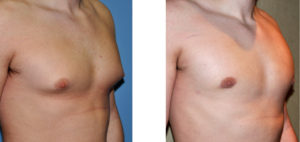
Some of these ‘newer’ gynecomastia are quite simple to treat. With the contemporary male model image of a very flat chest (I call it the Abercrombie Fitch look), some teenagers and men in their 20s and 30s want a small change in their chest contour by decreasing any projection of the nipple-areolar complex. Traditional liposuction, done aggressively under the nipple, works quite well for this small reduction.
The next gynecomasia problem is in the overweight patient who has a large chest and small pseudo breasts. Liposuction, with or without a superior crescent nipple lift, helps the chest contour but the nipple never really gets as high up on the chest wall as we would like. Similarly, the male who has lost a lot of weight usually due to bariatric surgery, poses a difficult problem due to the excess hanging skin. Proper nipple position can never really be obtained in these patients without a lot of undesired scarring.
Then there is the older male who has a combination of loose skin, low nipple position, and a ‘deflated’ chest appearance. Liposuction, nipple lifts, and occasionally pectoral implants can help rejuvenate the aged chest appearance. This is a problem of tissue volume loss and loose skin, the opposite of the younger gynecomastia patient.
Dr Barry Eppley
Indianapolis, Indiana


